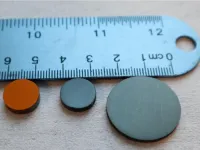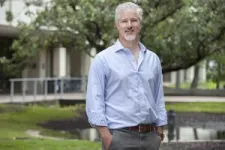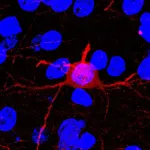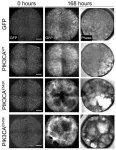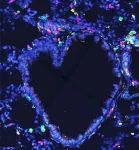(Press-News.org) UNIVERSITY PARK, Pa. — Perovskites, a family of materials with unique electric properties, show promise for use in a variety fields, including next-generation solar cells. A Penn State-led team of scientists created a new process to fabricate large perovskite devices that is more cost- and time-effective than previously possible and that they said may accelerate future materials discovery.
“This method we developed allows us to easily create very large bulk samples within several minutes, rather than days or weeks using traditional methods,” said Luyao Zheng, a postdoctoral researcher in the Department of Materials Science at Penn State and lead author on the study. “And our materials are high quality — their properties can compete with single-crystal perovskites.”
The researchers used a sintering method called the electrical and mechanical field-assisted sintering technique (EM-FAST) to create the devices. Sintering is a commonly used process to compress fine powders into a solid mass of material using heat and pressure.
A typical process for making perovskites involves wet chemistry — the materials are liquefied in a solvent solution and then solidified into thin films. These materials have excellent properties, but the approach is expensive and inefficient for creating large perovskites and the solvents used may be toxic, the scientists said.
“Our technique is the best of both worlds,” said Bed Poudel, a researcher professor at Penn State and a co-author. “We get single-crystal-like properties, and we don’t have to worry about size limitations or any contamination or yield of toxic materials.”
Because it uses dry materials, the EM-FAST technique opens the door to include new dopants, ingredients added to tailor device properties, that are not compatible with the wet chemistry used to make thin films, potentially accelerating the discovery of new materials, the scientists said.
“This opens up possibilities to design and develop new classes of materials, including better thermoelectric and solar materials, as well as X- and γ-ray detectors,” said Amin Nozariasbmarz, assistant research professor at Penn State and a co-author. “Some of the applications are things we already know, but because this is a new technique to make new halide perovskite materials with controlled properties, structures, and compositions, maybe there is room in the future for new breakthroughs to come from that.”
In addition, the new process allows for layered materials — one powder underneath another — to create designer compositions. In the future, manufactures could design specific devices and then directly print them from dry powders, the scientists said.
“We anticipate this FAST perovskite would open another dimension for high throughput material synthesis, future manufacturing directly printing devices from powder and accelerating the material discovery of new perovskite compositions,” said Kai Wang, an assistant research professor at Penn State and a co-author.
EM-FAST, also known as spark plasma sintering, involves applying electric current and pressure to powders to create new materials. The process has a 100% yield — all the raw ingredients go into the final device, as opposed to 20 to 30% in solution-based processing.
The technique produced perovskite materials at .2 inch per minute, allowing scientists to create quickly create large devices that maintained high performance in laboratory tests. The team reported their findings in the journal Nature Communications.
Penn State scientists have long used EM-FAST to create thermoelectric devices. This work represents the first attempt to create perovskite materials with the technique, the scientists said.
“Because of the background we have, we were talking and thought we could change some parameters and try this with perovskites,” Nozariasbmarz said. “And it just opened a door to a new world. This paper is a link to that door — to new materials and new properties.”
Other Penn State researchers on the project were Wenjie Li and Dong Yang, assistant research professors; Ke Wang, staff scientist in the Materials Research Institute; Jungjin Yoon, Tao Ye and Yu Zhang, postdoctoral researchers; Yuchen Hou, doctoral candidate; and Shashank Priya, former associate vice president for research and director of strategic initiatives and professor of materials science and engineering.
Also contributing was Mohan Sanghadasa, U.S. Army Combat Capabilities Development Command Aviation and Missile Center.
Researchers received support from the National Science Foundation Industry-University Research Partnerships’ Center for Energy Harvesting Materials and Systems, U.S. Department of Energy’s Office of Energy Efficiency and Renewable Energy, Air Force Office of Scientific Research, and Office of Naval Research and Army Research.
END
New method creates material that could create the next generation of solar cells
Process fabricates large perovskites faster, with less waste
2023-02-25
ELSE PRESS RELEASES FROM THIS DATE:
PETA scientists’ roadmap to animal-free research gets COVID-era update
2023-02-25
Washington — PETA scientists have just released a new edition of the groundbreaking Research Modernization Deal (RMD), the world’s first comprehensive plan for phasing out the use of animals in experimentation. The update is packed with new, cutting-edge information and reflects the latest scientific developments and regulatory changes since the RMD was first introduced in 2018.
The RMD provides detailed information about the pressing need to transition toward human-relevant research, and this new edition outlines non-animal methods for studying COVID-19. It also ...
Excess weight, obesity more deadly than previously believed
2023-02-25
Excess weight or obesity boosts risk of death by anywhere from 22% to 91%—significantly more than previously believed—while the mortality risk of being slightly underweight has likely been overestimated, according to new CU Boulder research.
The findings, published Feb. 9 in the journal Population Studies, counter prevailing wisdom that excess weight boosts mortality risk only in extreme cases.
The statistical analysis of nearly 18,000 people also shines a light on the pitfalls of using ...
Clues about the northeast’s past and future climate from plant fossils
2023-02-25
Ancient climates can help us understand the past, but also the future. 23 million years ago, in a time called the Miocene Epoch, Connecticut was around five to six degrees warmer than today and located roughly where Long Island is now. By the end of the Miocene, around five million years ago the earth had gradually cooled, Antarctica was glaciated, and there was some Arctic ice as well.
This cooling scenario moved in the opposite direction of today’s changing climate. One difference UConn Department of Earth Sciences Assistant Professor in Residence Tammo Reichgelt points out is that in the past, these changes happened gradually, spaced ...
A new epigenetic brain defense against recurrence of opioid use
2023-02-25
Substance use disorder (SUD) is an extremely difficult disorder to overcome, and many individuals with SUD return to regular use after repeated attempts to quit.
A return to regular drug use can be caused by the body’s physical dependence on the drug as well as experiences associated with prior drug use. Exactly how these drug associations are formed in the brain and how they trigger a return to drug use remain unclear.
“Individuals make long-lasting associations between the euphoric experience of the drug and the people, places and things associated with drug use,” said Christopher Cowan, Ph.D. professor in the Department ...
Markey Cancer Center study shows potential for new radiopharmaceutical cancer treatment
2023-02-24
LEXINGTON, Ky. (Feb. 24, 2023) — A recent University of Kentucky Markey Cancer Center study suggests a new radiopharmaceutical compound may be a viable treatment option for patients with advanced cervical cancer.
The study, led by UK Markey Cancer Center radiation oncologist Charles Kunos, M.D., and published in Frontiers in Oncology, validates that the radioactive drug 212Pb-DOTAM-GRPR1 may be useful in the treatment of persistent, recurrent, or metastatic cervical cancer.
Radiopharmaceuticals are expected to play ...
A mysterious object is being dragged into the supermassive black hole at the Milky Way’s center
2023-02-24
For two decades, scientists have observed an elongated object named X7 near the supermassive black hole at the center of the Milky Way and wondered what it was. Was it pulled off a larger structure nearby? Was its unusual form the result of stellar winds or was it shaped by jets of particles from the black hole?
Now, having examined the evolution of X7 using 20 years of data gathered by the Galactic Center Orbit Inintiative, astronomers from the UCLA Galactic Center Group and the Keck Observatory propose that it could be a cloud of dust and gas that was ejected during the collision of two stars.
Over time, they report, X7 has stretched, and it is being pulled apart ...
How a new blood-vessel-on-a-chip can help researchers further understand vascular malformations
2023-02-24
CHAPEL HILL, N.C. – Our bodies are made up of 60,000 miles of complex pipes that play a vital role in transporting nutrients throughout our bodies, performing waste disposal, and supplying our organs with fresh oxygen and blood.
Vascular malformations (VMs) are a group of rare genetic disorders that causes an abnormal formation of veins, arteries, capillaries, or lymphatic vessels at birth. VMs can interfere with the duties of our precious pipes by causing blockages, poor drainage, and the formation of cysts and tangles.
To address a need for further study, William Polacheck, PhD, an assistant professor at the ...
CHOP researchers identify molecules that optimize immune presentation of antigens across the human population
2023-02-24
Philadelphia, February 24, 2023—Researchers at Children’s Hospital of Philadelphia (CHOP) have identified variants of a chaperone molecule that optimizes the binding and presentation of foreign antigens across the human population, which could open the door to numerous applications where robust presentation to the immune system is important, including cell therapy and immunization. The findings were published today in Science Advances.
Class I major histocompatibility complex (MHC-I) proteins are ...
Researchers find several oceanic bottom circulation collapses in the past 4.7 million years
2023-02-24
Antarctic bottom water (AABW) covers more than two-thirds of the global ocean bottom, and its formation has recently decreased. However, its long-term variability has not been well understood.
Researchers led by Prof. DENG Chenglong from the Institute of Geology and Geophysics (IGG) of the Chinese Academy of Sciences (CAS) and their collaborators have reconstructed AABW history back to approximately 4.7 million years ago (mya). They found that AABW has collapsed several times and such collapses might have induced moisture transport to fuel the Northern Hemisphere ...
Protection against allergic asthma: When innate lymphoid cells educate alveolar macrophages
2023-02-24
A study conducted by researchers at the University of Liège on group 2 innate lymphoid cells (or ILC2s) shows that the functional reprogramming of these cells following their exposure to viruses allows our body to react differently to exposure to certain respiratory allergens. This study is published in Science Immunology.
The hygiene hypothesis states that exposure during childhood to certain micro-organisms protects against the development of allergic diseases such as asthma. In this context, researchers from the immunology-vaccinology laboratory (FARAH research ...
LAST 30 PRESS RELEASES:
Reducing social isolation protects the brain in later life
Keeping the heart healthy increases longevity even after cancer
Young adults commonly mix cannabis with nicotine and tobacco
Comprehensive review illuminates tau protein's dual nature in brain health, disease, and emerging psychiatric connections
Book prepares K-12 leaders for the next public health crisis
Storms in the Southern Ocean mitigates global warming
Seals on the move: Research reveals key data for offshore development and international ecology
Sports injuries sustained during your period might be more severe
World's first successful 2 Tbit/s free-space optical communication using small optical terminals mountable on satellites and HAPS
Can intimate relationships affect your heart? New study says ‘yes’
Scalable and healable gradient textiles for multi‑scenario radiative cooling via bicomponent blow spinning
Research shows informed traders never let a good climate crisis go to waste
Intelligent XGBoost framework enhances asphalt pavement skid resistance assessment
Dual-function biomaterials for postoperative osteosarcoma: Tumor suppression and bone regeneration
New framework reveals where transport emissions concentrate in Singapore
NTP-enhanced lattice oxygen activation in Ce-Co catalysts for low-temperature soot combustion
Synergistic interface engineering in Cu-Zn-Ce catalysts for efficient CO2 hydrogenation to methanol
COVID-19 leaves a lasting mark on the human brain
Scientists use ultrasound to soften and treat cancer tumors without damaging healthy tissue
Community swimming program for Black youth boosts skills, sense of belonging, study finds
Specific depressive symptoms in midlife linked to increased dementia risk
An ‘illuminating’ design sheds light on cholesterol
Who is more likely to get long COVID?
Study showcases resilience and rapid growth of “living rocks”
Naval Research Lab diver earns Office of Naval Research 2025 Sailor of the Year
New Mayo-led study establishes practical definition for rapidly progressive dementia
Fossil fuel industry’s “climate false solutions” reinforce its power and aggravate environmental injustice
Researchers reveal bias in a widely used measure of algorithm performance
Alcohol causes cancer. A study from IOCB Prague confirms damage to DNA and shows how cells defend against it
Hidden viruses in wastewater treatment may shape public health risks, study finds
[Press-News.org] New method creates material that could create the next generation of solar cellsProcess fabricates large perovskites faster, with less waste
